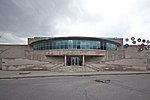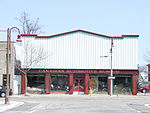Oshawa Metal
1986 establishments in OntarioBuildings and structures in OshawaGeneral Motors factoriesMotor vehicle assembly plants in Canada
Oshawa Metal or Oshawa Metal Centre is a General Motors of Canada facility in Oshawa, Ontario. Built in 1986 to supply metal for Chevrolet Lumina and Buick Regal made in Oshawa, the plant now makes steel used at the Oshawa Car Assembly plant and other GM customers. It is GM's only metal facility in Canada located close to an assembly plant. The 587,000 square feet (54,500 m2) facilities makes over 80,000 parts a day using 337 tons of steel a day to make 22 million parts a year.
Excerpt from the Wikipedia article Oshawa Metal (License: CC BY-SA 3.0, Authors).Oshawa Metal
Stevenson Road South, Oshawa
Geographical coordinates (GPS) Address Nearby Places Show on map
Geographical coordinates (GPS)
| Latitude | Longitude |
|---|---|
| N 43.870363888889 ° | E -78.874883333333 ° |
Address
Building P
Stevenson Road South 880
L1J 5Y6 Oshawa
Ontario, Canada
Open on Google Maps






